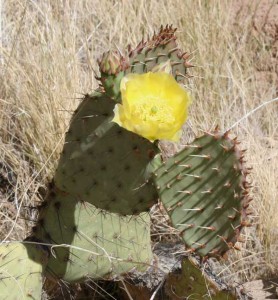Prickly Pear Cactus
Prickly Pear Cactus- Opuntia
According to the U. S. Department of Agriculture “prickly pear” in the cactus family is the common name for the genus Opuntia, which contains  many different species found in North and South America and surrounding environs. They are more commonly found in deserts but there are varieties that thrive in the Great Plains and American Southeast. For a list of prickly pear cacti, see below in notes of interest. All have flat, fleshy pads that look like large leaves. The pads are actually modified branches or stems that serve several functions — water storage, photosynthesis and flower production.
many different species found in North and South America and surrounding environs. They are more commonly found in deserts but there are varieties that thrive in the Great Plains and American Southeast. For a list of prickly pear cacti, see below in notes of interest. All have flat, fleshy pads that look like large leaves. The pads are actually modified branches or stems that serve several functions — water storage, photosynthesis and flower production.
Description:
Most prickly pear cactus have large spines which grow on the pads and stems from tubercles (small bumps). Around the large spines are clusters of fine, tiny, barbed spines called glochids. Glochids easily detach from the plant and can lodge into skin. Most prickly pear cacti can have yellow, red or purple flowers, even among the same species. They vary in height from less than a foot, such as the plains or hedgehog, to over 6 feet, such as the blind prickly pear or pancake. Pads can vary in width, length, shape and color. While all varieties have glochids, certain varieties such as the blind pear, are regarded as spineless.
Location:
While many people associate cactus with the desert, prickly pear cacti varieties can be found in different environments. Englemann’s prickly pear cactus can be found in the Sonoran and Chihuahuan deserts while the coastal prickly pear can be found in California and the grassland prickly pear can be found in the Great Plains in the U.S.
Edible:
The fruits of most prickly pear cactus are edible. Prickly pear branches and pads can be cooked and eaten as a vegetable. Prickly Pear Nectar is made with the juice and pulp of the fruits. The fruits and pads of the prickly pear cactus are rich in slowly absorbed soluble fibers that may help keep blood sugar stable. According to Web MD, “Prickly pear cactus might lower blood sugar levels in people with diabetes. Watch for signs of low blood sugar (hypoglycemia) and monitor your blood sugar carefully if you have diabetes and use prickly pear cactus” Some side effects of eating prickly pear include mild diarrhea, nausea, increased amount and frequency of stool, bloating and headache.
Notes of Interest:
A dye was made by Native Americans and settlers with the blood of cochineal bugs, an insect that feeds on the pads of the prickly pear.
A cactus moth, Cactoblastis cactorum, that is native to South America was inadvertently introduced into the United States in the Southeast and is making its way west. It presents a potential problem since it is largely unchecked by nature in North America. The potential destructive effect will not only be the loss of millions of dollars in revenue to farmers and producers but also to the environment where the impact on animals that depend on the prickly pear for food and shelter could potentially be enormous. This is just another example of human stupidity and carelessness.
Prickly Pear cactus Species: Brazilian prickly pear, semaphore prickly pear, sour prickly pear, California prickly pear, brownspined prickly pear, Tucson prickly pear, Big Bend prickly pear, Graham’s prickly pear, chenille prickly pear, border prickly pear, golden prickly pear, Rio Grande prickly pear, beavertail prickly pear, Trelease’s beavertail prickly pear, Chihuahua prickly pear, Chisos Mountain prickly pear, dollarjoint prickly pear, searchlight prickly pear, grassland prickly pear, erect prickly pear, Edwards’ prickly pear, Texas prickly pear, brittle prickly pear, violet prickly pear, tulip prickly pear, arborescent prickly pear, coastal prickly pear, purple prickly pear, twistspine prickly pear, common prickly pear, chaparral prickly pear, tulip prickly pear, Pinkava’s prickly pear, plains prickly pear, El Paso prickly pear, grizzlybear prickly pear, Navajo Bridge prickly pear, hairspine prickly pear, cockspur prickly pear, roving prickly pear, blind prickly pear, blood-red prickly pear, Santa Rita prickly pear, erect prickly pear, marblefruit prickly pear, bell-flower prickly pear, woollyjoint prickly pear, elephantear prickly pear, turban prickly pear, San Antonio prickly pear, Vasey’s coastal prickly pear, Wooton’s prickly pear